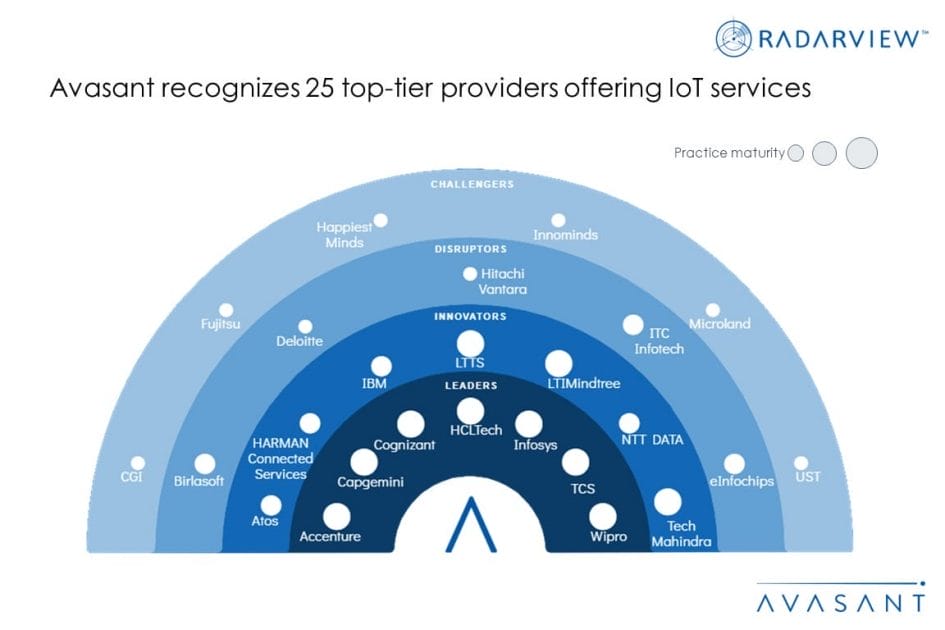IoT technology has become mainstream, as evidenced by the steady rise in the adoption of connected devices. The share of production-grade projects increased from 68% in 2021 to 73% in 2022. Across three key segments—Industrial Internet of Things (IIoT), connected infrastructure, and Consumer IoT—IIoT continues to lead in adoption driven by smart manufacturing and Industry 4.0 use cases, including digital twins. The connected infrastructure segment saw significant growth pushed by smart city initiatives, including urban mobility, energy management, and waste management. Sustainability has emerged as a new growth lever in IoT services.
These and other trends focused on the demand-side and supply-side are covered in our Internet of Things Services 2023 Market Insights™ and Internet of Things Services 2023 RadarView™, respectively. These reports present a comprehensive study of IoT service providers and closely examine market leaders, innovators, disruptors, and challengers.
We evaluated 42 service providers across three dimensions: practice maturity, partner ecosystem, and investments and innovation. Of the 42 providers, we recognized 25 that brought the most value to the market during the past 12 months.
The report recognizes service providers in four categories:
-
- Leaders: Accenture, Capgemini, Cognizant, HCLTech, Infosys, TCS, and Wipro
- Innovators: Atos, HARMAN Connected Services, IBM, LTTS, LTIMindtree, NTT DATA, and Tech Mahindra
- Disruptors: Birlasoft, Deloitte, Hitachi Vantara, ITC Infotech, and eInfochips
- Challengers: CGI, Fujitsu, Happiest Minds, Innominds, Microland, and UST
Figure 1 below from the full report illustrates these categories:

“With the rising complexities in the underlying infrastructure and growing IoT devices, enterprises must reassess their needs,” said Kim Terry, Avasant fellow. “As IoT at the edge represents a step change, enterprises must pick a platform with strong functionality and capabilities spanning the edge to the cloud.”
The reports provide a number of findings, including the following:
-
- There is a huge push toward implementing digital twins across industries, especially for use cases such as predictive maintenance, process optimization, remote monitoring, and product design.
- Enterprises have increased their focus on using IoT to effectively achieve their sustainability goals for use cases such as smart cities, energy management, waste management, asset utilization, and water management, directly impacting the United Nations Sustainable Development Goals.
- Manufacturing, healthcare, and utilities remain the top three adopters of IoT in terms of industry verticals, with the three combined making up 64% of the total projects in the IoT space.
“To mitigate new IoT vulnerabilities, organizations need to make IoT security an integral part of their strategy, design, and implementation process,” said Shwetank Saini, associate research director at Avasant. “Enterprises must adopt a zero-trust security approach with a focus on delivering speed and scale.”
The report also features detailed RadarView profiles of 25 service providers, along with their solutions, offerings, and experience in assisting enterprises in their IoT services digital transformation journeys.
This Research Byte is a brief overview of the Internet of Things Services 2023 Market Insights™ and Internet of Things Services 2023 RadarView™. (click for pricing).





